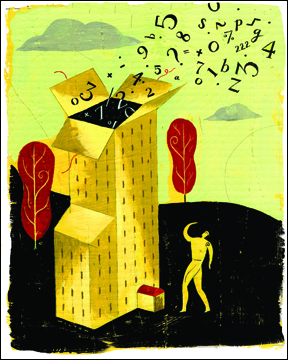Many business executives are wondering about all the buzz surrounding radio frequency identification. What makes a radio-powered microchip with a serial number so important? The answer, says Glover Ferguson, chief scientist at Accenture, a consulting and technology services company, can be summed up in one word: information.
Ferguson envisions a world in the not-too-distant future when every product and asset—from jet engine parts to important documents—will have RFID tags that will enable these inanimate objects to communicate information about themselves to computers. Accenture calls this “silent commerce.” But Ferguson sees this as only the first stage in a trend toward what he calls “reality online.”
|
|
Once individual objects can be identified, companies can add temperature, motion, radiation and other sensors, as well as miniature microphones or video cameras. Then, not only will these objects be able to identify themselves to computers, they’ll be able to provide information about their status and condition. That data can be stored online to create a digital representation of the physical world—a virtual double of the real world.
“We spend a lot of time trying to get data: ‘What’s the inventory level, what’s our backlog, where is the shipment?’ When we finally get this information it’s from the past,” says Ferguson. “What if all that information was online? What if you knew at any given moment exactly what your inventory was and where the shipment was? Now, we’re putting reality itself online.”
Combining RFID tags and other sensing devices with Web services and wireless communications will deliver a spectacular array of information. Objects will be able to tell us about themselves. Shelves will be able to send wireless instant messages to store clerks when they need to be replenished. Bearings on industrial machines will alert maintenance that they will soon need to be replaced. Sensors in food packaging will warn retailers that meat has been contaminated. These scenarios may sound futuristic, but reality is already moving online.
A Services Platform
“We’ve got all these technologies becoming available and the bandwidth to get at all this information,” Ferguson says. “Now everything we build can be a platform through which services can be delivered.”
RFID is a key element of reality online because it provides both a means of identifying the object and transmitting information to computer systems. As tag and reader prices come down, RFID will proliferate because companies need ways to gather accurate real-time information.
Ferguson cites numerous RFID applications already delivering strong returns on investment. FedEx couriers can unlock doors and start their vehicle using a wristband instead of keys. Millions of consumers purchase more gasoline and convenience snacks because they can do so with the swipe of a key fob. And millions of farmers deliver the right food and medicine to individual livestock.
The potential applications for RFID-sensors is almost unlimited. A Swiss railroad has been using a combination sensor and RFID device that lies underneath trains, measuring the temperature of car axles as they go by using an infrared sensor.
“Hot axles imply worn bearings, which can eventually lead to derailed trains,” Ferguson says. “RFID can tell you exactly which car needs to come off and that it has to come off now. That increases the operational effectiveness and safety of the transport system.”
Vitally needed standards for presenting and exchanging data are being developed today and are close to adoption. “You can see the beginnings of a common language that different companies providing gadgets will use to express this data,” Ferguson explains. “That makes it much more usable than if you have 37 different proprietary interfaces to plug in to to get any value out of the data.”
Silent commerce and reality online will be aided by many parallel developments. A key element is the Auto-ID Center, a partnership of global companies and research universities to create standards and an infrastructure to enable computers to identify any object anywhere in the world instantly.
Active Objects
This and other efforts “have moved up the timeframe by at least five or six years,” Ferguson says. “We’re going from a world where everything just lays around like an inert object to where the objects are actually participating in the economy and helping us.”
He warns that companies should not wait to implement RFID and that businesspeople should not consider it as simply a bar code replacement. If you do that, “you are missing the revolution,” he warns. RFID, silent commerce and—in the not too far out future—reality online can do so much more than simple bar codes that organizations need to consider restructuring the way they do work to take advantage of the value that this new technology enables.
Ferguson gets extremely excited by the prospect when he talks about it. But he takes pains to explain that most of the needed technology exists today and that this is not just a pie-in-the-sky idea way off in the future.
“It’s unstoppable, it’s inexorable,” he says. “This is going to happen.” •
RFID Opportunities and Challenges
RFID can provide a wide variety of benefits across many industries. But there are also major obstacles to overcome in deploying the technology. Building an infrastructure that handles the data and then making use of the data are the biggest hurdles.
Most companies that are implementing or testing RFID today are looking to improve specific processes or to relieve known bottlenecks. Companies are using RFID technology today for many applications and many industries. Ford Motor Co. uses RFID tags to enhance its automobile manufacturing processes. At its Essex, Ont., factory, an RFID tag is attached to each engine. Scottish Courage Brewery uses RFID to reduce the number of kegs it loses each year.
No matter what the industry or the applicaiton, early adopters of RFID technology still face some major hurdles. Among the most significant challenges will be dealing with the enormous volumes of data generated and integrating it with existing IT and supply chain applications. RFID tags provide not only information on the manufacturer and stock-keeping unit, like bar codes; they also can carry a serial number for specific products.
Data Overload
And RFID systems can provide date stamps for when a shipment arrived in a distribution center, when the goods were shipped to the store, and maybe one day, how long it sat on the shelves. “Current supply chain and retail systems don’t have the fields to store this kind of data, much less do anything with it,” says Stan Taylor, managing partner of Accenture Technology Labs.
Just how much data will RFID entail? Jim Crawford, vice president of Retail Forward, a retail strategy consulting company, estimates that Wal-Mart could collect as much as 7.7 million terabytes of data per day if all items in all its U.S. retail stores were tagged.
But that’s just the beginning. The data gathered by RFID tags is only a portion of the information that will be generated by silent commerce, which involves the broader use of sensors. These can include cameras, accelerometers and time and temperature sensors that deliver data about products and corporate assets, says Joseph Tobolski, senior manager of Accenture Technology Labs. That should make data storage vendors excited at the prospect for RFID, he jokes.
The challenge will be identifying what needs to be stored and analyzed and what data can be safely discarded. Accenture expects many companies to take an evolutionary approach to managing RFID data.
First, Taylor says, the early adopters will be challenged to build or acquire special RFID data equipment that will be used for collecting and holding transaction data. These “interim” platforms will eventually be replaced by commercial products that support RFID. Second, the infrastructure will need to dumb data down to what existing systems can digest now, Taylor says. “If they work in SKUs, RFID data needs to be formatted to meet that,” he says. Third, the interim infrastructure will have to do some analytics— such as determining market trends, shipping patterns, etc.—and reporting, since current systems can’t do that.
Building Infrastructure
Many companies will build the needed data infrastructures over a two- to four-year period. It will require putting in place adequate storage systems and networking technology and the bandwidth needed for moving huge volumes of data.
Many businesses might have to rely on homegrown applications for systems integration, analytics and reporting. But because some major retailers and manufacturers are beginning to demand that their supply chain partners use RFID, software applications vendors like SAP and Oracle likely will begin offering platforms that support RFID data within a year or two, according to Tobolski. “People will be looking to applications vendors to provide some sort of rudimentary functionality for RFID, although it may not be robust at first,” he says.
Another issue that could slow adoption concerns the sharing of data between supply chain partners. This includes ensuring the security and integrity of information and the privacy of consumers. Taylor believes dominant players in the retail and manufacturing sectors will play a large role in determining how companies will share data gathered from RFID systems—as well as who owns the data.
“This will evolve depending on who the 800-pound gorilla is,” Taylor says. “They will set the pace.” He says standards organizations and government regulators also will play key roles in determining formats for the sharing and aggregation of data, as well as data retention periods and security. None of these things will be decided overnight.
“Whenever you have something that requires coordination between companies, that will slow down the process,” Taylor says.
Then there’s the matter of cost. While expensive for some applications, prices of readers and tags have come down in recent years and Accenture expects the decreases to continue. Tobolski believes RFID will become less costly overall as applications are built into computing platforms, much the way Internet browsers have become standard applications on desktop computers. “We’ll see more commoditization,” Tobolski says.
Despite the challenges, Taylor and Tobolski remain quite confident that the coming months and years will see adoption of RFID technology at a fast pace.



